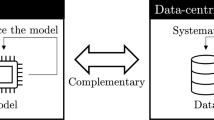Abstract
To remain competitive, companies must face the changes occurring in their environment and adapt their business processes accordingly. Those processes are implemented in business process management systems (BPMS), which mostly support manual adaptations. That means that the process users have to detect what changes in the environment require process adaptation, and what adaptation operations have to be performed. Such manual adaptations of processes are costly, time-consuming and error prone tasks. For this reason, some contributions of the literature have tried to address the issue of self-adaptations of processes. But these contributions suffer from shortcomings: isolated use of adaptation techniques, non-coverage of the process dimensions and of the adaptation types, etc.; the adaptation issue remains partially addressed. Thus we recommend in this paper a hybrid approach to ensure autonomic adaptations of running processes. According to this approach, the Plan component tries to find an appropriate model version of the concerned process. Then, if such a version does not exist, it looks to reuse an adaptation case that was applied in the past under a similar situation (context). Finally, if necessary, it applies rules, as an artificial intelligence planning technique, to define an ad hoc adaptation. Moreover, the recommended approach takes advantage of the IBM MAPE-K (Monitor, Analyze, Plan, Execute—Knowledge) control loop from autonomic computing, recognized as a prominent solution for self-adaptation at run-time. More precisely the paper addresses the resolution of adaptation needs while covering three process dimensions and all adaptation types and ensuring the separation of concerns for better portability and wide usability through the BPMN standard. It presents both the required Knowledge and the Plan component of the control loop for this resolution. It also shows the effectiveness of the approach by illustrating self-adaptation of a process from the crisis domain, and demonstrates its feasibility by reporting about its implementation and qualitative and quantitative evaluation.








Similar content being viewed by others
References
Oukharijane J, Ben Said I, Chaâbane MA, Andonoff E, Bouaziz R (2019) Towards a new adaptation engine for self-adaptation of BPMN processes instances. In: 14th International conference on evaluation of novel approaches to software engineering, pp 218–225
IBM (2006) An architectural blueprint for autonomic computing. IBM White Paper, vol 31
Reichert M, Weber B (2012) Enabling flexibility in process-aware information systems: challenges, methods, technologies. Springer, New York
Müller R, Greiner U, Rahm E (2004) Agentwork: a workflow system supporting rule-based workflow adaptation. Data Knowl Eng 51(2):223–256
Heinrich B, Schiller A, Schön D, Szubartowicz M (2020) Adapting process models via an automated planning approach. J Decis Syst 29(4):223–259
Minor M, Bergmann R, Görg S (2014) Case-based adaptation of workflows. Inf Syst 40:142–152
Milani F, Dumas M, Ahmed N, Matulevičius R (2016) Modelling families of business process variants: a decomposition driven method. Inf Syst 56:55–72
Ellouze F, Chaâbane MA, Andonoff E, Bouaziz R (2017) Onto-VP2M: a new approach to model and manage collaborative process versions using contexts and ontologies. Int J e-Collab 13(3):39–62
Ben Said I, Chaâbane MA, Andonoff E, Bouaziz R (2018) BPMN4VC-modeller: easy-handling of versions of collaborative processes using adaptation patterns. Int J Inf Syst Change Manag 10(2):140–189
Ayora C, Torres V, Pelechano V, Alférez GH (2012) Applying CVL to business process variability management. In: VARiability for you workshop: variability modeling made useful for everyone, pp 26–31
Oliveira K, Castro J, España S, Pastor O (2013) Multi-level autonomic business process management. In: International conference on enterprise, business-process and information systems modeling, pp 184–198
Ferro S, Rubira C (2015) An architecture for dynamic self-adaptation in workflows. In: International conference on software engineering research and practice (SERP), pp 35–41
Seiger R, Huber S, Heisig P, Assmann U (2019) Enabling self-adaptive workflows for cyber-physical systems. Softw Syst Model 18(2):1117–1134
Kephart JO, Walsh WE (2004) An artificial intelligence perspective on autonomic computing policies. In: Fifth IEEE International workshop on policies for distributed systems and networks, pp 3–12
Oukharijane J, Chaâbane MA, Ben Said I, Andonoff E, Bouaziz R (2020) A hybrid approach based on reuse techniques for autonomic adaptation of business processes. In: International conference on Software and Systems Reuse, pp 35–51
Ketfi A, Belkhatir N, Cunin P-Y (2002) Adaptation dynamique, concepts et experimentations. International Conference Software & Systems Engineering and their Applications. France, Paris
Aamodt A, Plaza E (1994) Case-based reasoning: Foundational issues, methodological variations, and system approaches. AI Commun 7(1):39–59
M. Fantinato, M.B.F.d. Toledo, L.H. Thom, I.M.d.S. Gimenes, R.d.S. Rocha, and D.Z.G. Garcia, “A survey on reuse in the business process management domain”, International Journal Business Process Integration and Management, vol. 6, no. 1, pp. 52–76, 2012.
Weber B, Rinderle-Ma S, Reichert M (2008) Change patterns and change support features - enhancing flexibility in process-aware information systems. Data Knowl Eng 66(3):438–466
A. Delgado and D. Calegari, “A generic BPMS user portal for business processes execution interoperability”, in Latin American Computer Conference, 2019, pp. 1–10.
D. Rodriguez, B. Remedi, and A. Guggeri, “Generic BPMS user portal”, 2018. https://gitlab.fing.edu.uy/opencoal/portalbpms.
Weske M (2007) Business process management-concepts, languages, architectures. Springer, Verlag, Berlin
Kherbouche MO (2013) Contribution à la gestion de l’évolution des processus métiers. Université du Littoral Côté d’Opale, Thesis
Rinderle S (2004) Schema evolution in process management systems. Université de Ulm, Thesis
M. A. Chaâbane, E. Andonoff, R. Bouaziz, and Lotfi Bouzguenda, “Modélisation multidimensionnelle des versions de processus”, Ingénierie des systèmes d’information. Lavoisier, 15(5), pp. 89–114.
Oukharijane J, Yahya F, Boukadi K, Ben-Abdallah H (2018) Towards an approach for the evaluation of the quality of business process models. In: International conference on computer systems and applications, 2018
Author information
Authors and Affiliations
Corresponding author
Additional information
Publisher's Note
Springer Nature remains neutral with regard to jurisdictional claims in published maps and institutional affiliations.
Rights and permissions
About this article
Cite this article
Oukharijane, J., Chaabâne, M.A., Ben Said, I. et al. Self-adaptive business processes: a hybrid approach for the resolution of adaptation needs. Innovations Syst Softw Eng 18, 61–83 (2022). https://doi.org/10.1007/s11334-021-00417-3
Received:
Accepted:
Published:
Issue Date:
DOI: https://doi.org/10.1007/s11334-021-00417-3




